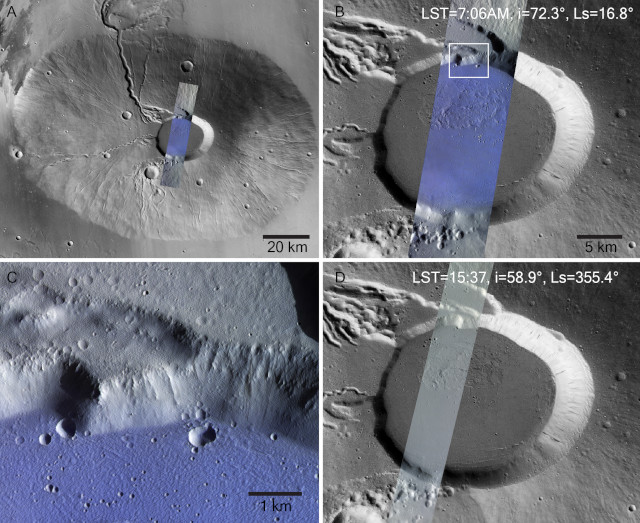
An article published in the journal “Nature Geoscience” reports the detection of frost on volcanoes in the Tharsis region on Mars. A team of researchers used data obtained from two ESA space probes, the ExoMars mission’s TGO and Mars Express, which made it possible to discover for the first time the presence of frozen water on the Martian surface at the red planet’s equator. In the calderas of the big volcanoes of Tharsis, blue deposits that can be attributed to water ice were spotted which are present only in the morning and then evaporate a few hours later.
The image (ESA/TGO/CaSSIS) shows the Ceraunius Tholus volcano as seen by the TGO space probe’s CaSSIS instrument. In panel A is a wide-angle view taken in the early hours of the Martian morning with the frost shown in the bluish rectangle. In panel B there’s a zoom of the caldera area. In panel C the zooming is higher to show a small area of the caldera where there is frost, which is absent on the rim. Panel D shows the same area as B observed at a different time, when frost is absent.
The estimated thickness of the frost layer detected is only one hundredth of a millimeter but it covers a very large area. The microclimate that might exist in those calderas could include a water cycle with implications for the possibilities of habitability by humans.
Traces of ice on the surface of Mars were already found but conditions at the red planet’s equator didn’t seem suitable for its formation due to solar radiation, which keeps temperatures relatively high during the Martian day. The Tharsis region is studied for the presence of volcanoes, which include Olympus, Arsia, and Ascraeus Montes, and Ceraunius Tholus, among the largest in the solar system. However, some observations offered surprises.
Mars is studied by various space probes that are in different orbits and only some of them can observe the Tharsis region during the morning. The chances of identifying the frost layer are further reduced by the fact that it forms during the cold seasons. An observation conducted for some other research surprised the researchers with the detection of frost in the calderas of the large volcanoes of Tharsis.
It took a combination of detections by the ExoMars mission’s TGO (Trace Gas Orbiter) space probes and Mars Express to understand what happens in the calderas of the Tharsis volcanoes. The TGO’s Color and Stereo Surface Imaging System (CaSSIS) instrument detected bluish deposits in calderas and their slopes during Mars’ cold seasons but only during the morning and then disappeared in the afternoon. The presence of water ice is confirmed by spectroscopic observations conducted with the TGO’s Nadir and Occultation for Mars Discovery (NOMAD) instrument and by images from the Mars Express space probe.
At the latitudes of Tharsis, the atmosphere is very thin, so the researchers didn’t expect that frost could be deposited in the calderas of its volcanoes. The bluish color of the frost deposits, also visible in the image, is due to the combination of near-infrared and visible frequency filters used to construct the images of the CaSSIS instrument.
In the reconstruction made by the researchers, a microclimate allows the formation of frost thanks to the unique circulation of air above the tops of the volcanoes. Winds rising up each caldera from the bases of the volcanoes carry water in what might be a water cycle. The result is that frost is deposited in the morning and then evaporates after a few hours.
The estimated thickness of the frost layer detected is only one hundredth of a millimeter but it covers several calderas. The consequence is that the quantity of water present is at least 150,000 tonnes. Having confirmation of a water cycle would help better understand the processes taking place in a large region of Mars. Knowing the water cycles on the red planet is essential to understanding how to obtain it for astronauts on a future mission and possible colonists in an even more distant future.

